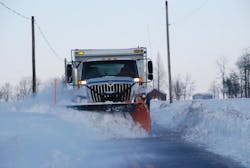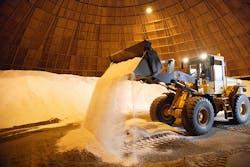Yet much of work fighting the blizzards and ice storms now engulfing large swaths of the nation actually began several months ago, as state DOTs loaded up on sand, salt, and other de-icing chemical concoctions, as well as prepping their fleets of snow plows and other equipment to do battle with the elements.
Indeed, Melinda Peters, the chief administrator for Maryland’s State Highway Administration (SHA) noted at a media event back in November that “winter operations” have completely changed over the last 25 years – progressing from what she called “thumb-tacks on a paper map and phone based command-field operations” to a network of high-tech cameras and pavement sensors feeding into a computer-heavy centralized “operations center.”
SHA also beefed up its real-time traffic camera network this year with an additional 15 state-owned and 58 local feeds, helping its operators access real-time road data for better deployment of crews and equipment. “The more ‘eyes’ we have on the road, the better our ability to pinpoint problem areas and deploy a rapid and precise response,” Peters explained.
Those newly acquired cameras and feeds boosted SHA’s network to nearly 700 camera images from state and local roads, she added, noting that SHA’s CHART (Coordinated Highway Action Response Team) emergency response vehicles now also have portable cameras to help the agency better diagnose incident-specific situations.
Additionally, SHA has 39 weather stations with pavement sensors and equipment, making it possible to monitor pavement temperatures, air temperatures, moisture and salinity on roadways across the Maryland.
Yet much of the pre-storm planning for winter operations takes place days in advance of predicted winter weather, Peters noted, with SHA treating interstates in advance of a storm using salt brine, which is a concentrated salt water solution.“Pre-treating with salt brine helps prevent ice and snow from sticking or bonding to the pavement at the onset of a storm and allows maintenance crews to be ahead of the game [but] will not take place if a storm is forecast to begin as rain because the brine solution will wash off and be ineffective,” Peters said. “It is sprayed onto roads several hours or up to a few days prior to a storm, leaving a thin film of salt on the pavement.”
SHA noted that there are 14 salt brine facilities and 94 “salt barns” throughout Maryland, with such “barns” filled with a total of 380,000 tons of salt and nearly 900,000 gallons of salt brine to treat the more than 16,000 lane miles SHA-maintained roads.
The Virginia Department of Transportation (VDOT) engages in similar strategies, especially in terms of road pre-treatment, but also deploys some new equipment to help speed up snow clearing efforts.
For the North Virginia area alone, VDOT built a “super-sized salt dome” last year it can stock with 22,000 tons of salt – about three times the capacity of a typical dome – to help ensure its crews don’t run low on materials during severe storms.
VDOT’s crews also focus on “pre-treating” 850 lane miles of so-called “trouble spots” on local Northern Virginia highways, including some 350 lane miles on interstates 66, 95, 395, and 495 – including bridges and ramps prone to freezing – with liquid magnesium chloride along with 500 lane miles on “major roads” using salt brine.
The agency pointed out that as the pre-treatment program is expanded, the need for salt to melt ice is reduced as “brine,” made up of 77% water and 23% salt, prevents ice from bonding to the road surface and is less costly.
Altogether, VDOT is responsible for 17,737 lane miles in Fairfax, Loudoun, Prince William counties that comprise the bulk of “Northern Virginia,” with about half of those miles made up of highways with the other half neighborhood streets.
VDOT is also deploying a new jet-powered snow melter for “park-n-ride” commuter parking lots this year to help eliminate massive snow piles that block spaces. The agency is also using seven high-pressure flush trucks to clear snow and ice around the “bollards” or special post dividers separating express and regular lanes on the I-495 Beltway.
Then there’s a new truck-mounted weather station that helps provides mobile measurements on road conditions (dry, moist, wet, snow, ice) as well as surface, dew point and air temperature, humidity and thickness of ice – all to help ensure that crews do not over- or under-apply chemicals.
VDOT also rolled out a new web tool this year called vdotplows.org. Once it snows more than two inches, residents in Fairfax, Loudoun and Prince William counties can enter their address and a color-coded snow map shows whether plowing is underway, completed or not yet started in their neighborhood.
Those are just a few examples of new tactics and strategies being deployed by state DOT agencies across the U.S. this year to fight winter weather – a fight that’s already turned into a fierce slugging match early in the 2013-2014 winter season.


